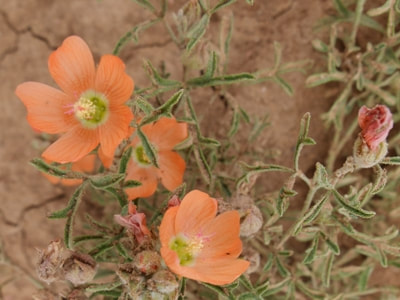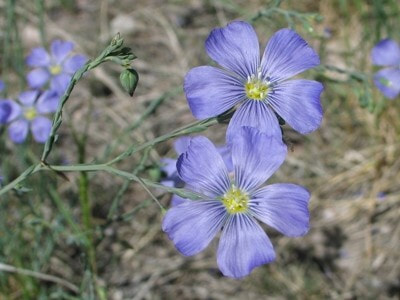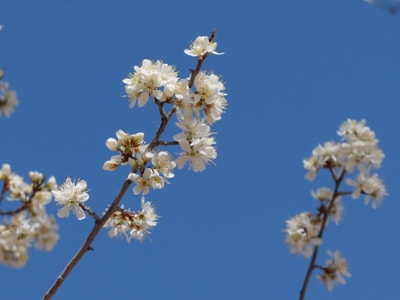Scarlet Beeblossom, Scarlet Gaura, Scarlet Evening Primrose, Linda Tarde,Oenothera suffrutescens,5/29/2020 Evening Primrose Family (Onagreaceae)
Found in dry open areas, roadsides Seen blooming in May in Abiquiu Airy and delicate in appearance, Scarlet Beeblossom grows to 1½ feet tall and wide with thin branches from the base. It can form large colonies in disturbed areas and is considered a noxious weed in California. Leaves are narrow and grow close to the branches. The flowers are about ½ inch across and grow in a long cluster, often nodding at the tip. Flowers have four spoon-shaped petals which are initially white, becoming pink then red as they mature and wither. Eight long white stamens are tipped with red anthers. It is not toxic or strongly medicinal. The Navajo made a cold infusion (tea) for children to settle their stomachs after vomiting. The Lakota rubbed it on their hands to catch horses, apparently horses were curious about the smell so let people get close. Source. If you trying to identify a different flower then you can check what other flowers bloom this month. If you cannot identify a flower from the website send a photo and where you took it to [email protected]. Read online for tips.
0 Comments
Found in dry areas, canyons, hillsides
Seen blooming in May in Red Wash Canyon For most of the year you will walk past this twiggy, unpretentious shrub but at this time of the year, when it is in bloom, it is very conspicuous. It grows to about three feet tall with blue green to olive green branches and twigs growing at odd angles. Plants are either male or female and produce cones for reproduction rather than flowers. The photo is of the bright yellow, pollen-producing male. The species serves as food for wildlife and is eaten by livestock, especially sheep. This species of Ephedra has no ephedrine or pseudoephedrine and has no medicinal qualities; the commercial drug ephedrine comes from an Ephedra which grows in China or is produced synthetically. People of the Mormon faith brew a tea from these plants by steeping the stems in boiling water, giving it its common name. Source. If you trying to identify a different flower then you can check what other flowers bloom this month. If you cannot identify a flower from the website send a photo and where you took it to [email protected]. Read online for tips. Cowboy’s Delight, Scarlet Globemallow, Copper Mallow,Sphaeralcea coccinea,Mallow Family (Malvaceae)5/15/2020 Found in dry slopes, disturbed soil
Seen blooming in May by CR 142 This is one of six species of Globemallow that grow in our area and is the earliest bloomer. Also coming into bloom now is the Small-leaf Globemallow which is taller and has triangular leaves. Scarlet Globemallow grows from 4" to 16" in large patches, usually about 8" high. Leaves are deeply divided into three or five then divided again and can appear grayish-green from the fine silvery hairs that cover them. Sometimes the edges fold in making them appear even narrower. Flowers grow in a dense cluster at the end of the branches and have five orange petals forming a cup or saucer shape. The fruit produced is shaped like a cheese-wheel and splits apart into segments like an orange. Its common name of Cowboy’s Delight is said to come from the delight its bright colors gave to a cowboy in a dull, arid landscape. The Teton Sioux used it ceremonially. A paste was used as a cooling agent for burns, scalds, and sores. A tea was used as a lotion for skin diseases, and a tonic to improve appetite. The Navajo used a tea for improving the taste of bitter medicinal herbs. Crushed leaves were used as a poultice for skin irritations and as a shoe liner for blistered feet. Source. If you trying to identify a different flower then you can check what other flowers bloom this month. If you cannot identify a flower from the website send a photo and where you took it to [email protected]. Read online for tips. Found in dry meadows, slopes
Seen blooming in May in Abiquiu Blue Flax grows to over two feet tall with wiry, slender stems branching out from the base. It often can be found growing in large patches. Leaves are small and grayish-green. Flowers are one inch across and open in the morning for just one day. Color varies from pale blue to almost purple with a silky sheen. Native Americans consumed the seeds for their flavor and nutrients. A tea made from the stems and leaves was used to treat various medical problems such as eye infections, stomach disorders, and swellings. Livestock exhibits a state of drowsiness when feeding on Blue Flax. Blue Flax was used to make strong rope. Today a cultivated flax is still grown for its "linen" fiber and "linseed oil". Source. If you trying to identify a different flower then you can check what other flowers bloom this month. If you cannot identify a flower from the website send a photo and where you took it to [email protected]. Read online for tips. Found in moist areas, ditches, canyons
Seen blooming in April by the Tierra Azul Acequia, Abiquiu The Wild Plum grows to 15 feet tall as a small tree or as a large shrub forming thickets. The branches are thorny and the leaves are finely toothed. The upper surface of the leaves is dark green, the underside is pale. Pure white flowers bloom before the leaves in round clusters and have five petals and a slightly unpleasant fragrance. Flowers are followed by round fruits, plums, one inch across which can be yellow or red. Although the plums can be eaten raw, the quality is somewhat poor, the fruits are better used for preserves and jellies. Wild plums have toxic substances in all parts of the plant except the fruit but traditionally many parts are used for medicinal purposes. A tea made from the inner bark is used as a wash to treat various skin problems and as a mouth wash to treat sores, a poultice of the inner bark is disinfectant and is used as a treatment on cuts and wounds, it has been used to make a cough syrup and an infusion has been used in the treatment of diarrhea, kidney, bladder complaints and in the treatment of asthma. It also works well as a mild laxative. A green dye was made from the leaves and a red dye from the roots. Source. |
AuthorI am Marilyn Phillips, a native of England, whose love of nature and the outdoors from childhood brought me by a circuitous route to Crested Butte, Colorado in 1993 and 16 years later to northern New Mexico. My exploration of the many trails in these areas, my interest in wildflowers and photography, and career in computer system design came together in this creation. If you have any corrections, comments or questions, please contact me by email. Archives
September 2025
Categoriescopyright © 2020
|







 RSS Feed
RSS Feed